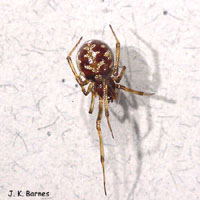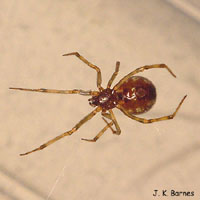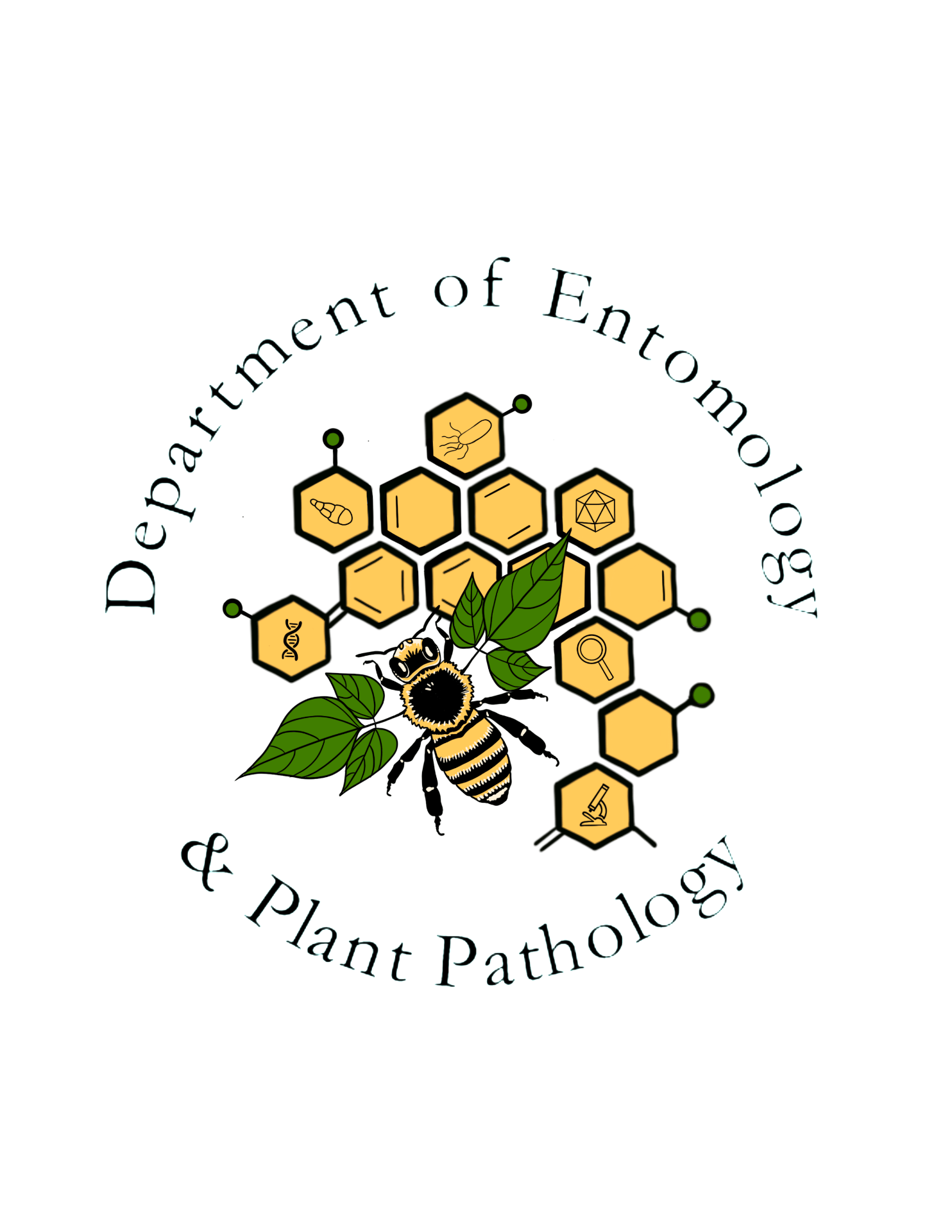Triangulate cobweb spider
Order: Araneae
Family: Theridiidae
Genus and species: Steatoda triangulosa (Walckenaer)


This small household spider is easily overlooked as it weaves cobwebs in the dark corners of houses, basements, and outbuildings. The body is only about 1/8 to ¼ inch long. The cephalothorax is brownish orange. Each segment of the yellow legs is darker apically. The finely pubescent abdomen is brown with a series of white and yellow roughly triangular spots mid-dorsally and irregular markings laterally.
This species is probably native to Eurasia and has been introduced to North America relatively recently. It is known from central and southern Europe, southern Russia, the Mediterranean, St. Helena, and the United States. It is rare in South America. In North America it is widespread and abundant locally in and on houses. In both Europe and North America it lives in houses in the northern part of its range and under stones and on walls of buildings in the southern part of the range (Levi 1957, 1962). It is common in towns and cities, in and around man-made structures, in dark corners of walls, lower angles of windows, and under eaves (Archer 1946).
Like other comb-footed spiders (family Theridiidae), these spiders build irregular webs and suspend themselves from these snares while waiting for unsuspecting prey to approach. Using a comb of serrated bristles on their hind legs they enswathe their prey in sticky silk and wait for it to quiet before approaching close enough to bite. Steatoda triangulosa is a frequent associate of the brown recluse and the common house spider in closets and crannies (Fitch 1963). It has been known to prey on many kinds of arthropods, including ants, spiders (including the brown recluse), ticks, and pillbugs (Guarisco 1991). In Texas it has been known to prey on fire ants and spiders inhabiting utility equipment housings (Horner and Russell 1986; MacKay and Vinson 1989).
Mating spiders and egg sacs have been found from late spring through early fall (Kaston 1981). Egg sacs, about the size of the adult spider, are made of loosely woven white silk, and about 30 eggs are visible inside each sac.
Severe envenomation is uncommon following the bite of Steatoda species, and there are no known cases of human envenomation by S. triangulosa. When Steatoda poisoning does occur, the neurotoxic symptoms are similar to those resulting from black widow bites. The related species Steatoda grossa, known as the false black widow or cupboard spider, has been blamed for severe local and regional pain, nausea, and vomiting in Australia. The symptoms, similar to those seen in latrodectism, have been treated successfully with Latrodectus antivenom (Graudins et al. 2002). In the United States, S. grossa is confined to the Gulf Coast and the West Coast (Levi 1957). Fortunately, it appears that this species does not occur in Arkansas. At least two species of Steatoda have also been implicated in human envenomations in Europe (Cavalieri et al. 1987; Warrell et al. 1991).
Another related species, S. borealis, is considered one of the comb-footed spiders of most concern to urban pest controllers, along with the black widow and common house spider (Snetsinger 1982). It is easily distinguished from S. triangulosa by the dark colored abdomen with a narrow, light colored median line. Although it is the most common Steatoda of the eastern United States, it has never been found in Arkansas and it is apparently rare south of Illinois, Iowa, and Nebraska (Levi 1957).
References:
Archer, A. F. 1946. The Theridiidae or comb-footed spiders of Alabama. Alabama Museum of Natural History Museum Paper 22: 67 pages.
Cavalieri, M., D. D’urso, A. Lassa, E. Pierdominici, M. Robello, and A. Grasso. 1987. Characterization and some properties of the venom gland extract of a theridiid spider (Steatoda paykulliana) frequently mistaken for black widow spider (Latrodectus tredecimguttatus). Toxicon 25 (9): 965-974.
Comstock, J. H. 1940. The spider book. Doubleday, Doran and Company, Inc., New York. 729 pages.
Fitch, H. S. 1963. Spiders of the University of Kansas Natural History Reservation and Rockefeller Experimental Tract. University of Kansas Museum of Natural History, Lawrence. 202 pages.
Graudins, A., N. Gunja, K. W. Broady, and G. M. Nicholson. 2002. Clinical and in vitro evidence for the efficacy of Australian red-back spider (Latrodectus hasselti) antivenom in the treatment of envenomation by a cupboard spider (Steatoda grossa). Toxicon 40 (6): 767-775.
Guarisco, H. 1991. Predation of two common house spiders upon medically significant pests. Transactions of the Kansas Academy of Science 94 (1-2): 79-81.
Horner, N. V., and D. Russell. 1986. Ummidia trapdoor spider caught in a Steatoda web (Araneae: Ctenizidae, Theridiidae). Journal of Arachnology 14: 142.
Kaston, B. J. 1981. Spiders of Connecticut. State Geological and Natural History Survey of Conecticut, Department of Environmental Protection Bulletin 70: 1020 pages.
Levi, H. W. 1957. The spider genera Crustulina and Steatoda in North America, Central America, and the West Indies (Araneae, Theridiidae). Bulletin of the Museum of Comparative Zoology 117 (3): 367-424.
Levi, H. W. 1962. The spider genera Steatoda and Enoplognatha in America (Araneae, Theridiidae). Psyche 69 (1): 11-36.
MacKay, P., and S. B. Vinson. 1989. Evaluation of the spider Steatoda triangulosa (Araneae: Theridiidae) as a predator of the red imported fire ant (Hymenoptera: Formicidae). Journal of the New York Entomological Society 97 (2): 232-233.
Warrell, D. A., J. Shaheen, P. D. Hillyard, and D. Jones. 1991. Neurotoxic envenoming by an immigrant spider (Steatoda nobilis) in southern England. Toxicon 29 (10): 1263-1265.
